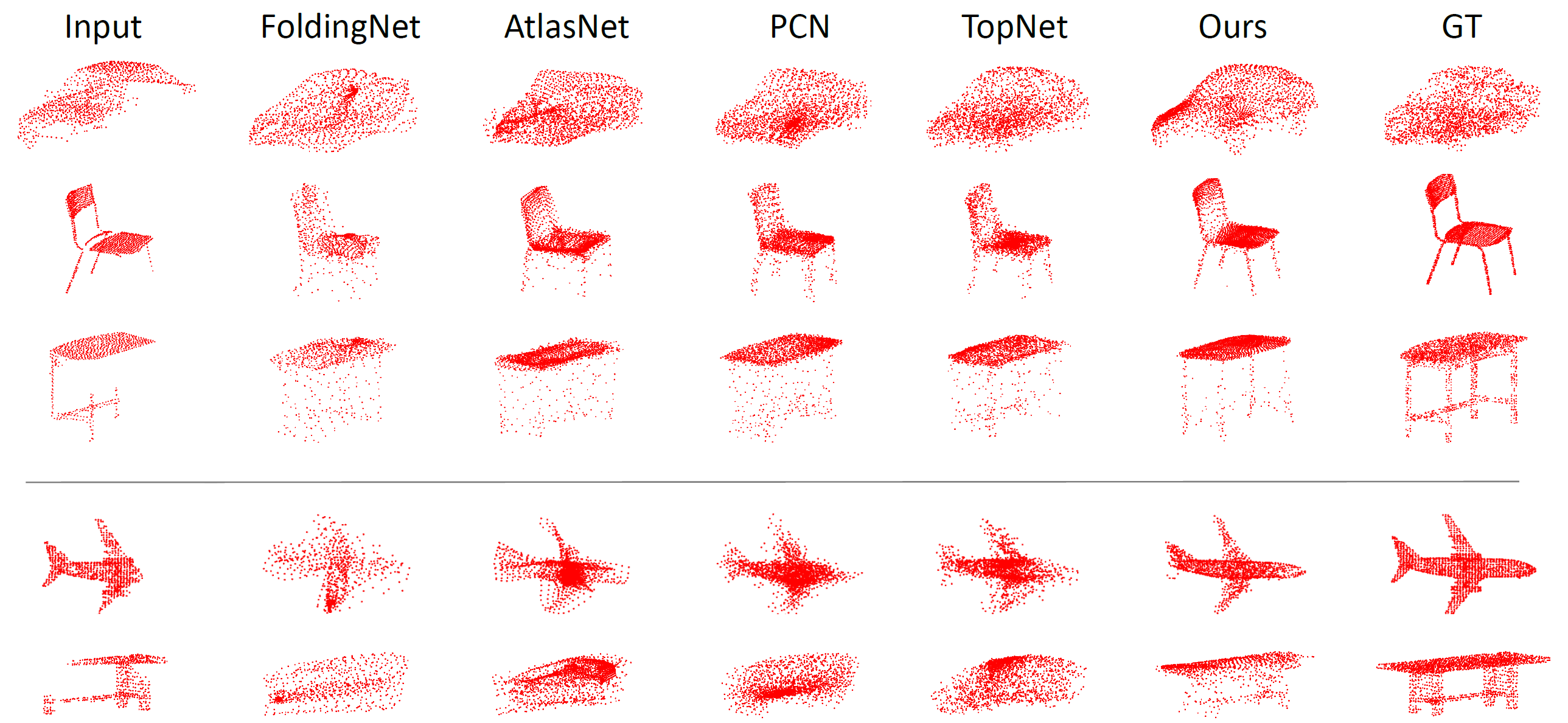 This paper proposes a general model for partial point clouds analysis wherein
the latent feature encoding a complete point clouds is inferred by applying a
local point set voting strategy. In particular, each local point set constructs
a vote that corresponds to a distribution in the latent space, and the optimal
latent feature is the one with the highest probability. We illustrates that this
proposed method achieves state-of-the-art performance on shape classification,
part segmentation and point cloud completion.
[paper]
[suppl]
This paper proposes a general model for partial point clouds analysis wherein
the latent feature encoding a complete point clouds is inferred by applying a
local point set voting strategy. In particular, each local point set constructs
a vote that corresponds to a distribution in the latent space, and the optimal
latent feature is the one with the highest probability. We illustrates that this
proposed method achieves state-of-the-art performance on shape classification,
part segmentation and point cloud completion.
[paper]
[suppl]
- Pytorch:1.5.0
- PyTorch geometric
- CUDA 10.1
- Tensorboard (optinoal for visualization of training process)
- open3D (optinoal for visualization of points clouds)
.
├── data_root
│ ├── ModelNet40 (dataset)
│ ├── ShapeNet_normal (dataset)
│ └── completion3D (dataset)
│
├── modelnet
│ ├── train_modelnet.sh
│ ├── evaluate_modelnet.sh
│ └── tensorboard.sh
│
├── shapenet_seg
│ ├── train_shaplenet.sh
│ ├── evaluate_shaplenet.sh
│ └── tensorboard.sh
│
├── completion3D
│ ├── train_completion3D.sh
│ ├── evaluate_completion3D.sh
│ └── tensorboard.sh
│
├── utils
│ ├── class_completion3D.py
│ ├── main.py
│ ├── model_utils.py
│ └── models.py
│
├── visulaization
│ ├── visualize_part_segmentation.py
│ └── visualize_point_cloud_completion.py
│
├── demo
│ ├── point_cloud_completion_demo.py
│ └── visualize.py
│
└── readme.md
The ModelNet40 (415M) dataset
is used to perform shape classification task. We provide a pretrained
model,
whose accuracy on complete point clouds is 92.0% and accuracy on parital point
clouds is 85.8%. Replace the --checkpoint flag in evaluate_modelnet.sh with
the path of pretrained model.
-
Enter
completion3D/cd completion3D/ -
Train the model.
./train_modelnet.sh
-
Visualize the training process in the Tensorboard.
./tensorboard.sh
-
Evaluate the trained model. Make sure that parameters in the evaluation are consistent with those during training.
./evaluate_modelnet.sh
The ShapeNet
(674M) dataset is used during experiments of part segmentation task. You can set
the --categories in train_shapenet.sh to specify which categories of
objects will be trained.
We provide a pretrained model,
whose class mean IoU (mIoU) on complete point clouds is 78.3% and mIoU on
parital point clouds is 78.3%. Replace the --checkpoint flag in
evaluate_shapenet.sh with the path of pretrained model.
-
Enter
shapenet_seg/cd shapnet_seg/ -
Train the model.
./train_shapenet.sh
-
Visualize the training process in the Tensorboard.
./tensorboard.sh
-
Evaluate your trained model. Make sure the parameters in
evaluate_shapenet.shis consistent with those intrain_shapenet.sh. Sample predicted part segmentation results are saved into:shapenet_seg/checkpoint/{model_name}/eval_sample_results/../evaluate_shapenet.sh
-
Visualize sample part segmentation results. After evaluation, three
.npyfiles are saved for each sample:pos_{idx}.npycontains the input point clouds;pred_{idx}.npycontains the predicted part labels;label_{idx}.npycontains the ground-truth labels.cd visulaization/ python3 visualize_part_segmentation.py --model_name {model_name} --idx {idx}
The Completion3D
(1.5GB) dataset is used during experiments of point cloud completion task.
Specifically, partial point clouds are taken as inputs and the goal is to infer
complete point clouds. Note that the sythetic partial point clouds are used
during training. Download dataset and save it to data_root/. You can set the
--categories in train_completion3D.sh to specify which category or
categories of object will be trained.
-
Enter
completion3D/cd completion3D/ -
Train the model.
./train_completion3D.sh
-
Evaluate the trained model. Make sure the parameters in the evaluation are consistent with those during training. Sample predicted completion results are saved into
completion3D/checkpoint/{model_name}/eval_sample_results/../evaluate_completion3D.sh
-
Visualize point cloud completionn results. After evaluation, four
.npyfiles are saved for each sample:pos_{idx}.npycontains the complete point clouds;pred_{idx}.npycontains the predicted complete point clouds;pos_observed_{idx}.npycontains the observed partial point clouds;pred_diverse_{idx}.npycontains a diverse predicted completion point clouds.cd visulaization/ python3 visualize_point_cloud_completion.py --model_name {model_name} --idx {idx}
Here we provide a quick demo for point cloud completion. Specically, the
pretraiend model
(pretrained only on cars from ShapeNet, and input cars are transformed to the
center of the bounding boxes) is used to do point cloud completion on partial
point clouds of vehicles generated from KITTI. The partial point cloud
generation process can be found in
here. Note
that input point clouds should be in .npy format and in the shape of (N, 3).
For example, if your input point clouds are in the demo/demo_inputs/*.npy and
pretrained model is in the demo/model_car.pth, run the following command:
cd demo/
python3 point_cloud_completion_demo.py \
--data_path demo_inputs \
--checkpoint model_car.pth \After running, predicted compeltion results will be saved in the
demo/demo_results/. Then visualize the results by running:
python3 visualize.py \
--data_path demo_inputs/{Input partial point clouds}.npy--data_path can be either set to a certain point cloud, such as
demo_inputs/000000_car_point_1.npy, or a directory containing input
parital point clouds, such as demo_inputs. In the later case, a random
sample from demo_inputs/ will be selected to visualize.
If you find this project useful in your research, please consider cite:
@article{pointsetvoting,
title={Point Set Voting for Partial Point Cloud Analysis},
author={Zhang, Junming and Chen, Weijia and Wang, Yuping and Vasudevan, Ram and Johnson-Roberson, Matthew},
journal={IEEE Robotics and Automation Letters},
year={2021}
}



